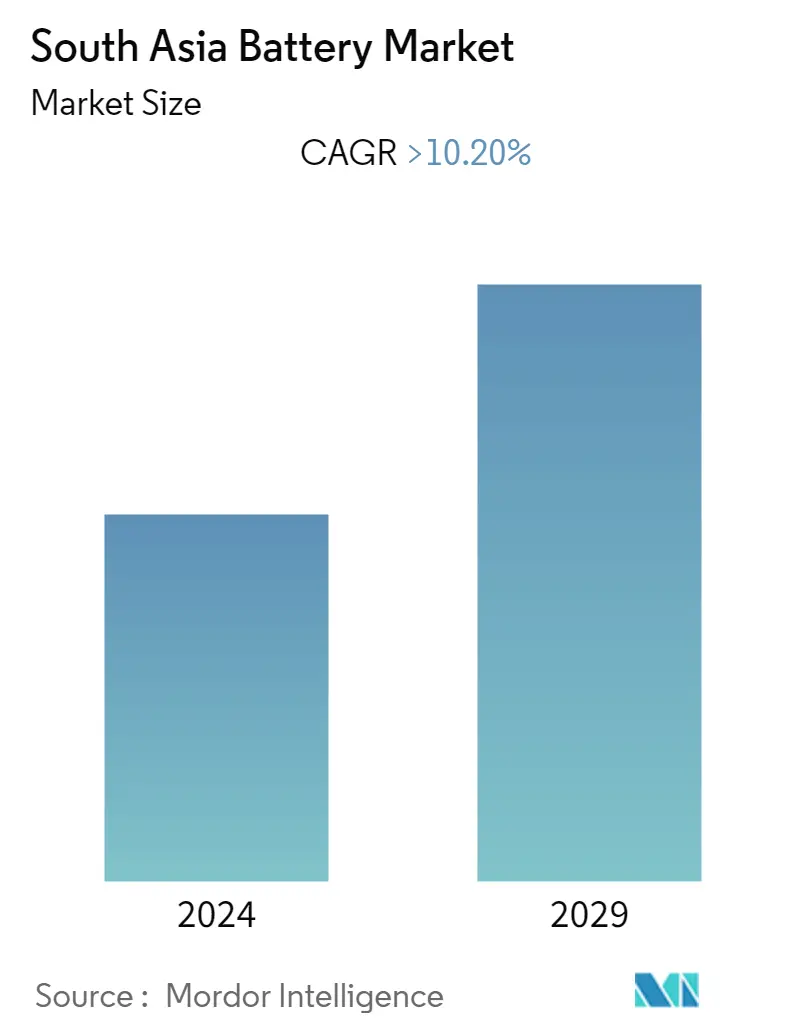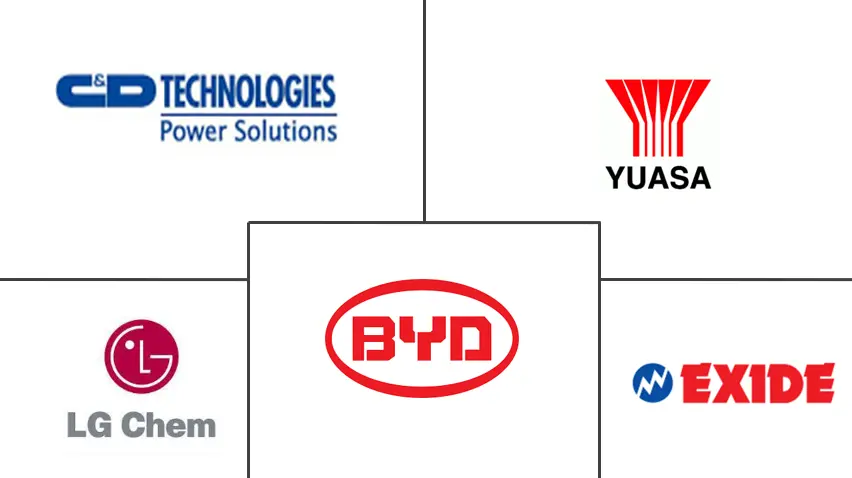Market Size of South Asia Battery Industry

| Study Period | 2021 - 2029 |
| Base Year For Estimation | 2023 |
| Forecast Data Period | 2024 - 2029 |
| Historical Data Period | 2021 - 2022 |
| CAGR | > 10.20 % |
Major Players
*Disclaimer: Major Players sorted in no particular order |
South Asia Battery Market Analysis
The South Asia Battery market is expected to witness a CAGR of more than 10.2% over the forecast period.
The market was negatively impacted by COVID-19. However, it has now reached pre-pandemic levels.
- Factors, such as the rapid adoption of the electric vehicle, due to the declining prices, mainly fostered by the declining price of lithium-ion batteries and the increasing demand for data centers in the region, are expected to drive the market studied.
- However, on the flip side, the region has less than 2% battery energy storage systems in comparison to the global scale battery energy storage system. Thus, less demand for energy storage systems is expected to restrain the market during the forecast period.
- The material handling industry is shifting toward li-ion batteries, as li-ion batteries provide higher efficiency compared to lead-acid batteries. Thus, this is expected to provide a great opportunity for Li-ion batteries.
- Thailand has a significant market share owing to the increasing demand from the automotive, data center, and other end-user sectors.
South Asia Battery Industry Segmentation
A battery comprises one or more cells connected in series, parallel, or both ways and is made for a particular output voltage and capacity. Likewise, a cell is an electrochemical component used to produce or store electrical energy in a battery.
The market is segmented by type, end users, and geography. By type, the market is segmented into lead-acid batteries, lithium-ion batteries, and other types. By end users, the market is segmented into automotive, data centers, telecommunication, energy storage, and other end users. The report also covers the market size and forecasts for the South Asian battery market across the major countries. For each segment, the market sizing and forecasts have been done on the revenue (USD Billion).
| Type | |
| Lead Acid Battery | |
| Lithium-ion Battery | |
| Other Types |
| End Users | |
| Automotive | |
| Data Centers | |
| Telecommunication | |
| Energy Storage | |
| Other End Users |
| Geography | |
| Singapore | |
| Thailand | |
| Indonesia | |
| Rest of South Asia |
South Asia Battery Market Size Summary
The South Asia battery market is poised for significant growth, driven by the rapid adoption of electric vehicles and the increasing demand for data centers. The decline in lithium-ion battery prices has made electric vehicles more accessible, fostering their adoption across the region. Additionally, the burgeoning data center industry, particularly in Singapore, is propelling the demand for batteries, as these facilities require reliable backup power solutions. Despite the market's recovery from the COVID-19 pandemic's impact, the region's low penetration of battery energy storage systems presents a challenge, potentially restraining market expansion. However, the shift towards lithium-ion batteries in the material handling industry offers substantial opportunities for growth, especially in Thailand, which holds a significant market share due to its robust automotive and data center sectors.
Thailand's strategic position as a leading automotive manufacturing hub in the Association of South Asian Nations, coupled with government incentives for eco-friendly vehicles, is expected to drive the demand for automotive batteries. The Thailand 4.0 Programme, focusing on advanced technologies, further supports this growth trajectory. The acquisition of data centers, such as Bridge Data Centres' expansion in Bangkok, underscores the increasing investment in data infrastructure, which is anticipated to boost battery demand. Key players in the partially fragmented market, including BYD Co. Ltd, C&D Technologies Inc., and Exide Industries Limited, are actively participating in this growth. Collaborative efforts, such as the research partnership between Livent Corporation and Nanyang Technological University, aim to advance eco-friendly lithium battery technologies, aligning with the region's sustainability goals.
South Asia Battery Market Size - Table of Contents
-
1. MARKET OVERVIEW
-
1.1 Introduction
-
1.2 Market Size and Demand Forecast, in USD billion, till 2027
-
1.3 Recent Trends and Developments
-
1.4 Government Policies and Regulations
-
1.5 Market Dynamics
-
1.5.1 Drivers
-
1.5.2 Restraints
-
-
1.6 Supply Chain Analysis
-
1.7 Industry Attractiveness - Porter's Five Forces Analysis
-
1.7.1 Threat of New Entrants
-
1.7.2 Bargaining Power of Consumers
-
1.7.3 Bargaining Power of Suppliers
-
1.7.4 Threat of Substitutes Products and Services
-
1.7.5 Intensity of Competitive Rivalry
-
-
-
2. MARKET SEGMENTATION AND ANALYSIS
-
2.1 Type
-
2.1.1 Lead Acid Battery
-
2.1.2 Lithium-ion Battery
-
2.1.3 Other Types
-
-
2.2 End Users
-
2.2.1 Automotive
-
2.2.2 Data Centers
-
2.2.3 Telecommunication
-
2.2.4 Energy Storage
-
2.2.5 Other End Users
-
-
2.3 Geography
-
2.3.1 Singapore
-
2.3.2 Thailand
-
2.3.3 Indonesia
-
2.3.4 Rest of South Asia
-
-
South Asia Battery Market Size FAQs
What is the current South Asia Battery Market size?
The South Asia Battery Market is projected to register a CAGR of greater than 10.20% during the forecast period (2024-2029)
Who are the key players in South Asia Battery Market?
BYD Co. Ltd, C&D Technologies Inc., Exide Industries Limited, GS Yuasa Corporation and LG Chem Ltd. are the major companies operating in the South Asia Battery Market.

